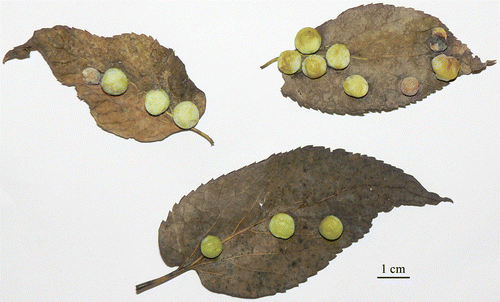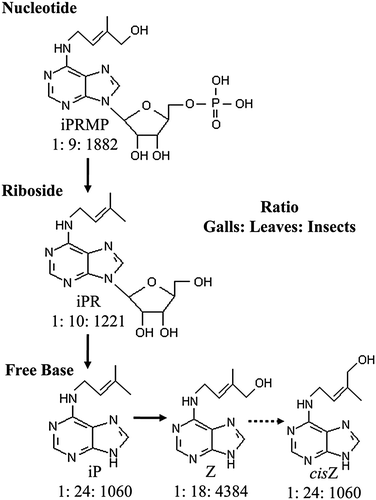Figures & data
Figure 1. Hackberry galls formed by the aphid Pachypsylla celtidis on leaves collected from the ground. The galls could be described as ‘green islands’, since they clearly appear green compared to the surrounding leaf tissue.

Figure 2. Differences in concentrations of total CK and ABA recovered from leaves and galls of Celtis occidentalis and larval Pachypsylla celtidis. Vertical bars represent standard error around the mean. Means with the same letter are not statistically different (p<0.05); lower-case letters are used to show relationships among total CK and upper-case letters are used for ABA.

Table 1. Concentrations of cytokinins isolated from leaves and galls of Celtis occidentalis and larval Pachypsylla celtidis, expressed as pmol·g fresh weight (means±SE, n=3). Mean concentrations of phytohormones with the same letter are not statistically different among tissues types, as determined using a one-way ANOVA with Tukey's post-hoc test (p<0.05). The abbreviation n.d. denotes no detection. Concentrations of CKs found by Mapes and Davies (2001) in Eurosta solidaginis taken from developing ball-galls on Solidago spp. are provided for comparison.
Figure 3. Proposed pathway of CK-metabolism by the larval gall-forming insect Pachypsylla celtidis on its host plant Celtis occidentalis (simplified from Sakakibara 2006). Ratios are based on concentrations of CK in galls, leaves, and insects. Note that cis-trans isomerization (broken arrow) is thought to occur enzymatically via zeatin cis-trans isomerase, but this has not yet been shown in plants; an alternative possibility is the production of cis forms through a separate pathway involving tRNA.
